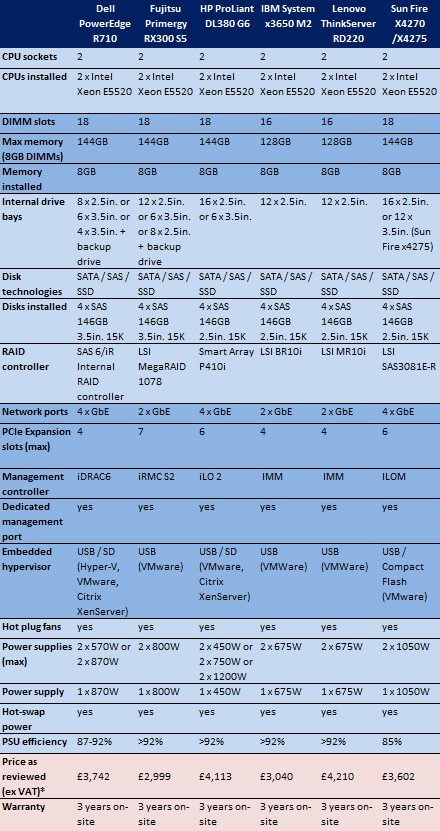Xeon 5500 (Nehalem) servers: round-up

The introduction earlier this year of Intel's Xeon 5500 Series processors has given the server market a major boost, and in more ways than one. Improved performance is the most obvious advance, with the 45nm Nehalem micro-architecture behind the 5500 series supporting dual or quad cores, with hyperthreading on some versions. Automatic over-clocking of individual cores is also supported, via what Intel calls Turbo Boost Technology.
The Xeon 5500 also sees the first major implementation of QuickPath. Intel's answer to AMD's HyperTransport, QuickPath eliminates the frontside bus (FSB) bottleneck that handicapped earlier designs, giving each core its own integrated memory controller plus a high-speed interconnect to other cores, memory and I/O. Add in support for masses of DDR3 RAM plus PCI Express Generation 2 technology — which doubles the I/O bandwidth — and the result is a leap forward in terms of processing power.
Exactly how much of a leap depends, of course, on the system configuration and applications involved. A recent Intel presentation claimed up to a nine-fold speed improvement compared to the typical end-of-life single-core Xeon servers that customers are currently looking to replace. Alternatively, with its additional power-saving features, the Xeon 5500 lets you do the same amount of work with fewer servers and reduce energy costs by up to 90 per cent, enabling the costs of upgrading to be recouped in just a few months.
With figures like these being bandied about, the major vendors have, understandably, rushed to bring products to market, and a variety of tower, rack and blade systems are now available. Just as with earlier Xeon servers, racks are likely to be the most popular format, with the six vendors featured here each selling both 1U and 2U products. With extra room for on-board storage and expansion, 2U servers are set to be the sweet spot and it's these we've concentrated on for our group round-up.
What we tested:

* 2 x Intel Xeon 5520 processors, 8GB RAM, 4 x 146GB SAS disks, single PSU
Editor's choice
We found it tricky to differentiate between the 2U Xeon 5500 servers reviewed here. Although there were minor differences, which we've pointed out in the reviews, the basic specifications were very similar: the same Intel chipset was employed in each case, along with dual processor sockets and — with just one exception (the IBM/Lenovo server) — the same RAM capacity. Storage options were also much the same, remote management was built in and the option to add an embedded hypervisor was, similarly, available across the board.
We didn't run any performance tests as it was outside the scope of this immediate preview round-up. However, for a long time now it's been pretty rare for a server vendor to leap ahead of the pack in any significant way. Prices are much the same too. As a result, buying a server is now more a matter of choosing a vendor or reseller with whom you're happy to deal or with whom you have an existing relationship. It's also important to compare the levels of service on offer, along with the extras — bundled and optional — such as management tools, and complementary networking and storage solutions.
Bearing all of these factors in mind, HP and the new ProLiant DL380 G6 are a hard act to beat — all the more so given the services, software and other products that can be wrapped around HP and its resellers' offerings.
Review ratings
We have therefore given the Editor's Choice award to the HP ProLiant DL380 G6. That said, Dell continues to chip away at HP's dominance in the server market, and its PowerEdge R710 runs the DL380 close. We were also very impressed by the Sun Fire X4270/X4275 — our only real concern with Sun is what might happen to the company once the Oracle takeover is finalised.
HP's ProLiant DL380 G6
(Credit: HP)